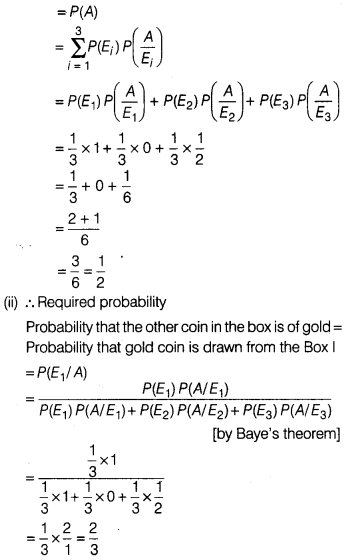CBSE Sample Papers for Class 12 Maths Set-5
Class 12thCBSE Sample Papers for Class 12 Maths Set-5
CBSE Sample Papers for Class 12 Maths Set 5 with Solutions
Time Allowed: 3 Hours
Maximum Marks: 80
General Instructions:
- This question paper contains – five sections A, B, C, D and E. Each section is compulsory. However, there are internal choices in some questions.
- Section A has 18 MCQ’s and 02 Assertion-Reason based questions of 1 mark each.
- Section B has 5 Very Short Answer (VSA) type questions of 2 marks each.
- Section C has 6 Short Answer (SA) type questions of 3 marks each.
- Section D has 4 Long Answer (LA) type questions of 5 marks each.
- Section E has 3 source based/case/passage based/intergrated units of assessment (4 marks each) with sub-parts.
Section
A
(Multiple Choice Questions)
Each question carries 1 mark
Question 1.
The sum of order and degree of the differential equation
(\(\frac{dy}{dx}\))² + 3y(\(\frac{d^2y}{dx^2}\)) = 0 is
(a) 1
(b) 2
(c)
3
(d) 4
Solution:
(c) We have,
(\(\frac{dy}{dx}\))² +
3y(\(\frac{d^2y}{dx^2}\)) = 0
Here, order = 2 and degree = 1
∴ Required
sum = 2 + 1 = 3
Question 2.
If y = x³ + tan x, then y” – 2 sec² x tan x equals
(a)
6
(b) 6x
(c) 3
(d) 3x
Solution:
(b) Given that
y = x³ + tan
x
On differentiating both sides w.r.t. x, we get
y’ = 3x² + sec² x
Again, on differentiating both sides w.r.t. x, we get
y” = 6x + 2sec² x tan
x
⇒ y” = -2sec² x tan x = 6x
Question 3.
If P(A) = \(\frac{7}{13}\), P(B) = \(\frac{9}{13}\) and P(A ∩
B) = \(\frac{4}{13}\), then P(\(\frac{A}{B}\)) equal
(a) \(\frac{1}{9}\)
(b) \(\frac{2}{9}\)
(c) \(\frac{3}{9}\)
(d) \(\frac{4}{9}\)
Solution:
(d) We know that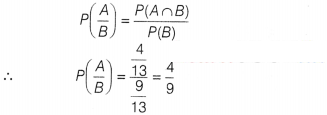
Question 4.
If x is real, then the minimum value of x² – 8x + 17 is
(a)
-1
(b) 0
(c) 1
(d) 12
Solution:
(c) Let f(x) = x² – 8x + 17
∴
f'(x) = 2x – 8
So, f (x) = 0, gives x = 4
Now, f” (x) = 2 > 0 , ∀ x
So, x = 4 is the point of local minimum.
∴ Minimum value of f (x) at x =
4
f (4) = 4 × 4 – 8 × 4 + 17
= 1
Question 5.
The feasible region for an LPP is shown in the following
figure.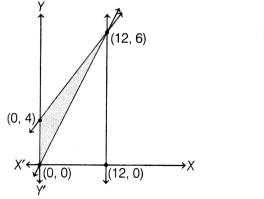
Let F = 3x – 4y be the objective function. Maximum value of F
is
(a) 0
(b) 8
(c) 12
(d) -18
Solution:
(c) The feasible
region as shown in the figure, has objective function F = 3x – 4y.
| Corner points | Corresponding value of F = 3x – 4y |
| (0, 0) | 0 |
| (12, 6) | 12 ← Maximum |
| (0, 4) | -16 |
Hence, the maximum value of F is 12.
Question 6.
If a leap year is selected at random, then what is the chance
that it will contain 53 Tuesday?
(a) \(\frac{1}{7}\)
(b)
\(\frac{2}{7}\)
(c) \(\frac{3}{7}\)
(d) \(\frac{5}{7}\)
Solution:
(b) In a leap year, there are 366 days i.e, 52 weeks and 2 days.
The two days
can be
(1) Sunday and Monday
(2) Monday and Tuesday
(3) Tuesday and
Wednesday
(4) Wednesday and Thursday
(5) Thursday and Friday
(6) Friday
and Saturday
(7) Saturday and Sunday
∴ Total number of cases = 7
Number
of favourable cases = 2
∴ Required probability = \(\frac{2}{7}\)
Question 7.
The value of λ, so that the vectors
\(\vec{a}=3\hat{i}+2\hat{j}+9\hat{k}\) and
\(\vec{b}=\hat{i}+\lambda\hat{j}+3\hat{k}\) are perpendicular to each other
is
(a) 15
(b) -15
(c) 12
(d) -12
Solution: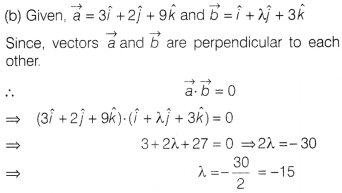
Hence, the required value of λ is -15.
Question 8.
Solve x³y dx = dy, given that y = 1 when x = 1
Solution:
(b) We have, x³y dx = dy ⇒ x³dx =
\(\frac{dy}{y}\)
On integrating both sides, we get
∫x³dx =
∫\(\frac{dy}{y}\) ⇒ \(\frac{x^4}{4}\) = logy + C …(i)
which is a general
solution of the given differential equation.
Also, given y = 1, when x =
1
∴ From Eq. (i), we get C = \(\frac{1}{4}\)
On putting the value of C in
Eq. (i), we get
Question 9.
If y = loga x, then \(\frac{dy}{dx}\) equal
to![]()
Solution:
(a) We have,
Question 10.
Which of the following statements is true for f(x) = 4x³ –
6x² – 72x + 30 ?
I. f is strictly increasing in the interval (-∞, -2).
II.
f is strictly increasing in the interval (3, ∞).
III. f is strictly
decreasing in the interval (-2, 3).
IV. f is neither increasing nor
decreasing in R.
(a) I and II are true
(b) II and III are true
(c) II
and IV are true
(d) All are true
Solution:
(d) We have, f(x) = 4x³ –
6x² – 72x + 30
On differentiating w.r.t. x, we get
f'(x) = 12x² – 12x –
72
= 12(x² – x – 6) = 12(x – 3) (x + 2)
Therefore, f'(x)= 0 gives x = – 2,
3.
The points x = – 2 and x = 3 divides the real line into three disjoint
intervals, namely, (-∞, -2), (-2, 3) and (3, ∞).
In the intervals (-∞, – 2) and (3, ∞), f'(x)is positive while
in the interval (- 2, 3), f'(x) is negative.
Consequently, the function f is
strictly increasing in the intervals (-∞, – 2) and (3, ∞) while the function is
strictly decreasing in the interval (-2, 3).
However, f is neither increasing
nor decreasing in R.
| Interval | Sign of f'(x) | Nature of function f |
| (-∞, -2) | (-)(-) > 0 | f is strictly increasing |
| (-2, 3) | (-)(+) < 0 | f is strictly decreasing |
| (3, ∞) | (+)(+) > 0 | f is strictly increasing |
Question 11.
If A and B are two independent events with P(A) =
\(\frac{3}{5}\) and P(B) = \(\frac{4}{9}\), then P(A’ ∩ B’) equal to
(a)
\(\frac{4}{15}\)
(b) \(\frac{8}{45}\)
(c) \(\frac{1}{3}\)
(d)
\(\frac{2}{9}\)
Solution:
(d)P{A’ ∩ B’) = -1 – P(A ∪ B)
= 1 -[P(A)+
P(B)-P(A ∩ B)]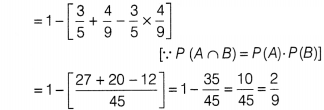
Question 12.
If A ⊂ B, then P(B / A) equals
(a) 1
(b) 0
(c)
0.5
(d) 0.25
Solution:
Question 13.
Evaluate \(\int_0^{2 \pi}\frac{3^{sin x}}{1+3^{sin x}}\)
(a) 2π
(b) \(\frac{\pi}{2}\)
(c) 3π
(d) π
Solution: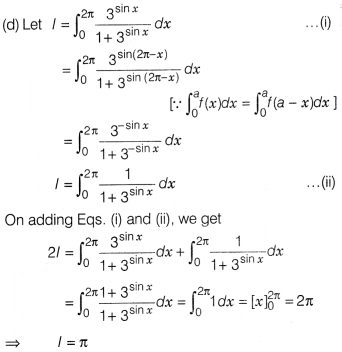
Question 14.
If y = tan x \(\frac{1}{3}\) log x – \(\frac{2}{x}\), then
\(\frac{dy}{dx}\) is equal to
(a) sec x – \(\frac{1}{3x}+\frac{2}{x^2}\)
(a) sec² x – \(\frac{1}{3x}+\frac{2}{x^2}\)
(c) sec x – 3x + x²
(d) None
of these
Solution:
(b) We have, y = tanx – \(\frac{1}{3}\) logx –
\(\frac{2}{x}\)
On differentiating both the sides w.r.t. x, we get
Question 15.
The equation of a line passing through the point (-3, 2, -4)
and equally inclined to the axes are
(a) x – 3 = y + 2 = z – 4
(b) x + 3 =
y – 2 = z + 4
(c) \(\frac{x+3}{1}=\frac{y-2}{2}=\frac{z+4}{3}\)
(d) None
of these
Solution:
(b) Here, l = m = n, therefore required equation of
line is![]()
∴ x + 3 = y – 2 = z + 4
Question 16.
Evaluate \(\int_{-1}^1\frac{3x^2}{1+4^{tan x}}\) dx.
(a)
1
(b) 2
(c) 3
(d) 0
Solution: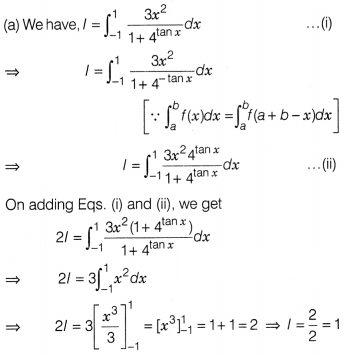
Question 17.
If |\(\vec{a}\)| = 20, |\(\vec{b}\)| = 4 and
\(\vec{a}.\vec{b}\) = 24, then |\(\vec{a}\times\vec{b}\)| is equal to
(a)
30
(b) 32
(c) 0
(d) 24
Solution: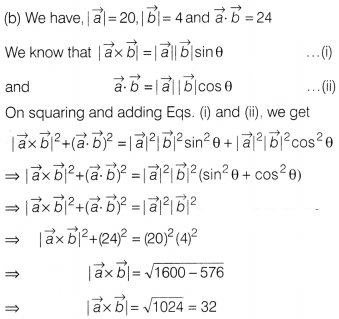
Question 18.
continuous at x = \(\frac{\pi}{2}\), when k equals
(a)
-6
(b) 6
(c) 5
(d) -5
Solution: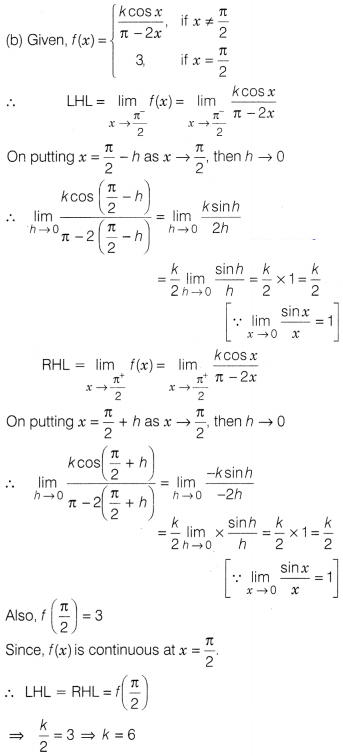
Assertion-Reason Based Questions
In the following questions, a statement
of Assertion (A) is followed by a statement of Reason (R). Choose the correct
answer out of the following choices.
(a) Both A and R are true and R is the
correct explanation of A
(b) Both A and R are true but R is not the correct
explanation of A
(c) A is true but R is false
(d) A is false but R is
true
Question 19.
Assertion (A) Let a relation R defined from set A = {1, 2, 5,
6} to A is
R = {(1, 1), (1, 6), (6, 1)}, then R is symmetric relation.
Reason (R) A relation R in set A is called symmetric, if (a, b) ∈ R
⇒ (b, a)
∈ R for every a, b ∈ A.
Solution:
(a) Assertion We have, A = { 1,2, 5,
6}
and R = {(1, 1), (1, 6), (6, 1)}
Here, (1, 6) ∈ R ⇒ (6, 1) ∈ R
So, R
is symmetric relation.
Hence, Assertion is true and Reason is also true and
Reason is the correct explanation of Assertion.
Question 20.
Assertion (A) The inverse of sine function is define in the
interval [-π, 0], [0, π] etc.
Reason (R) The inverse of sine function is
denoted by sin-1.
Solution:
(d) Assertion Sine function is
one-one and onto in the![]()
range is [-1, 1],
So, inverse of sine function is define
in each of these intervals.
Reason We denote the inverse of sine function by
sin-1 (arc sine function).
Hence, we can say that the Reason is
true and Assertion is false.
Section
B
(This section comprises of very
short answer type questions (VSA) of 2 marks each)
Question 21.
Evaluate ∫sin x sin 2 x sin 3x dx.
Or Evaluate ∫
tan4 x dx
Solution:
Let l = ∫sinx sin2x sin3xdx
=
\(\frac{1}{2}\)∫(2sinx sin2x)sin3x dx
= \(\frac{1}{2}\)∫(cosx – cos3x)sin3x
dx
= \(\frac{1}{4}\)∫(2sin3xcosx – 2sin3xcos3x)dx
= \(\frac{1}{4}\)∫(sin4x
+ sin2x – sin6x)dx
= \(\frac{1}{4}\)[-\(\frac{cos 4x}{4}-\frac{cos
2x}{2}+\frac{cos 6x}{6}\)] + C
Or
Let l = ∫tan4xdx
=
∫tan²x(sec²x -1)dx
= ∫tan² xsec² xdx – ∫tan²xdx
= ∫tan² xsec² xdx –
∫(sec²x -1)dx
On putting tan x=t and sec² xdx =dt in first integral, we get
= ∫ t²dt-
∫(sec²x – 1)dx
= ∫t²dt – ∫sec²xdx + ∫1dx
= \(\frac{r^3}{3}\) – tan x + C =
\(\frac{tan^{3}}{3}\) – (tan x – x) + C
Question 22.
If the points A(-1, 3, 2), B(-4, 2, -2) and C(5, 5, λ) are
collinear, find the value of λ.
Solution:
The equations of line passing
through A(-1, 3, 2) and 8(-4, 2, -2) is
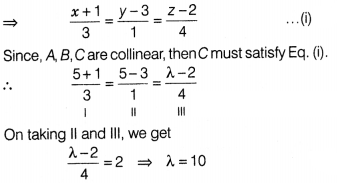
Question 23.
Show that the function f(x) = (x³ – 6x² + 12x -18) is an
increasing function on R.
Or
Prove that the function f given by f(x) = log
cos x is strictly decreasing x ∈ (0, \(\frac{\pi}{2}\)).
Solution:
We
have, f(x) = x³ – 6x² + 12x – 18
∴ f'(x) = 3x² – 12x + 12 = 3(x² – 4x +
4)
= 3(x – 2)² ≥ ∀ x ∈ R
∴ f'(x) ≥ 0 ∀ x ∈ R
Hence, f(x) is increasing
function on R.
Or
Given, f(x) = log cos x
On differentiating both sides
w.r.t. x, we get
∴ f'(x) = – tan x < 0
Hence, f(x) is strictly
decreasing. Hence proved.
Question 24.
Solve \(\frac{dy}{dx}\) + 2 y = e3x.
Solution:
We have, \(\frac{dy}{dx}\) + 2y = e3x
This is of the
form \(\frac{dy}{dx}\) + Py = Q.
Here, P = 2 and Q = e3x
∴ IF
=e∫2dx = e2x
The solution is given by
y × IF = ∫(Q ×
IF)dx + C
⇒ y e2x =∫e2x . e3xdx + C
⇒
ye2x = ∫e5xdx + C
⇒ ye2x =
\(\frac{1}{5}\)e5x + C
⇒ y = \(\frac{1}{5}\)e3x +
Ce-2x
Question 25.
Solve
\(\frac{dy}{dx}=\frac{3e^{2x}+3e^{4x}}{e^x+e^{-x}}\)
Solution:
⇒ dy = 3e3x dx
On integrating both sides, we
get
∫ldy = 3∫e3xdx ⇒ y = e3x + C
Section
C
This section comprises of short
answer type questions (SA) of 3 marks each
Question 26.
If y = (x)x + (sin x)x, then find
\(\frac{dy}{dx}\).
Solution:
Given, y = (x)x +(sin
x)x
Let u = (x)x and v = (sin x)x
Then,
given equation becomes, y = u + v
On differentiating both sides w.r.t. x, we
get
\(\frac{dy}{dx}=\frac{du}{dx}+\frac{dv}{dx}\) …..(i)
Consider, u =
xx
On taking log both sides, we get
log u = log
xx
⇒ log u = x log x [∵ log mn = n log m]
On differentiating both sides w.r.t. x, we get
dy_du dv dx dx dx [by using
product rule of derivative]
Consider, u = xx On taking log both sides, we get
log u = log xx => log u = x log x
[v log mt – n log m]
On
differentiating both sides w.r.t. x, we get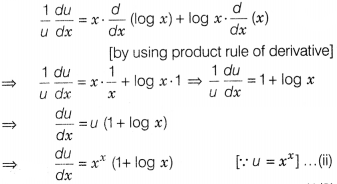
Now consider, v = (sin x)x
On taking log both sides, we get
log v = log (sin x)x
⇒ log v = x log (sin x) [∵ log mn
= n log m]
On differentiating both sides w.r.t. x, we get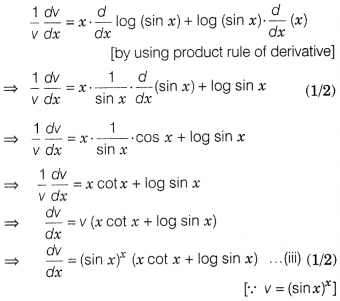
Now, from Eqs. (i), (ii) and (iii), we get
\(\frac{dy}{dx}\)= xx (1 + log x)+ (sin x)x (x cot x + log
sin x)dx
Question 27.
Let A = {1, 2, 3, ….,9} and R be the relation in A × A
defined by (a, b) R(c, d), if a + d = b + c for (a, b),(c, d) in A × A. Prove
that R is an equivalence relation.
Or
Prove that the relation R in set A =
{1, 2, 3, 4, 5} given by R = {(a, b) : |a – b| is even} is an equivalence
relation.
Solution:
Given, A = {1,2, 3,…,9} and a relation ft in A × A
defined by (a, b)R(c, d), if a + d =b + c.
Reflexivity Let (a, b) ∈ A × A be
any arbitrary element. Now, a + to = to + a
[∵ addition is commutative on the
set of real numbers]
Therefore, (a, b)R(a, b).
∵ (a, b) ∈ A × A was
arbitrary.
∴ R is reflexive.
Symmetricity Let (a, b),(c, d) ∈ A × A
such that (a, b)R(c, d).
∵ (a,
b)R(c, d)
∴ a + d=b + c
⇒ c + b = d + a
[∵ addition is commutative on
the set of real numbers]
⇒ (c, d)R(a, b)
So, R is symmetric.
Transitivity Let (a, b),(c, d),(e, f) ∈ A × A such that (a, b)R(c, d) and (c,
d)R(e, f).
Since, (a, b)R(c, d) and (c, d)R(e, f).
So. we have a + d = b +
c …(i)
and c + f = d + e …(ii)
On adding Eqs. (i) and (ii), we get
(a +
d)+(c + f) = (b + c)+(d + e)
⇒ a + f = b + e ⇒ (a, b)R(e, f)
So, R is
transitive.
Thus, R is reflexive, symmetric and transitive.
Hence, R is an
equivalence relation.
Or
The given relation is R = {(a, b):|a – b| is
even} defined on set A = {1,2, 3, 4, 5}.
To show that R is an equivalence
relation, we show that it is reflexive, symmetric and transitive.
(i) Reflexive As |x – x| = 0 is even, ∀ x ∈ A
⇒ (x, x) ∈ R, ∀ x ∈ A
Hence, R is reflexive.
(ii) Symmetric As, (x, y) ∈ R ⇒ |x – y| is even
[by the definition of
given relation]
⇒ |y – x| is also even [∵ |a| =|-a|, ∀ a ∈ R]
⇒ (y, x) ∈
R, ∀ x, y ∈ A
We have shown that (x, y) ∈ R ⇒ (y, x) ∈ R, ∀ x, y ∈ A
Hence, R is symmetric.
(iii) Transitive As (x, y) ∈ R and (y, z) ∈ R
⇒ | x – y| is even and | y –
z| is even.
[by using definition of given relation]
Now, |x – y| is
even
⇒ x and y both are even or odd. and |y – x|iseven
⇒ y and x both are
even or odd.
There are two cases arise.
Case I When y is even.
Now, (x, y)&R and (y, z) ∈ R.
⇒ |x – y| is
even and |y – z|iseven.
⇒ x is even and z is even ⇒ | x – z| is even [∵
difference of two even numbers is also even]
⇒ (x, z) ∈ R
Case II When y is odd.
Now, (x, y) ∈ R and (y, z) ∈ R
⇒ |x – y| is even
and |y – z| is even
⇒ x is odd and z is odd ⇒ |x – z| is even [∵ difference
of two odd numbers is even]
⇒ (x, z) ∈ R
So. we have shown that (x, y ) ∈
R and (y. z) ∈ R
⇒ (x. z) ∈ R. ∀ ,v. y, z ∈ A
∴ R is transitive.
Since,
R is reflexive, symmetric and transitive. So, it is an equivalence relation.
Question 28.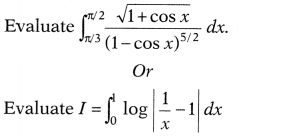
Solution: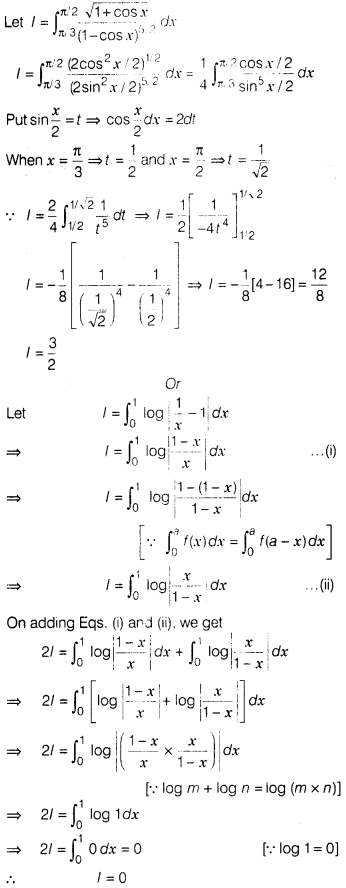
Question 29.
Find the area bounded by the curve y = cos x between x = 0
and x = 2 π.
Or
Find the area bounded by the curve y² = 4a²(x – 1) and the
lines x = 1 and y = 4a.
Solution:
The graph of y = cos x between 0 to 2π
is the curve shown in given figure.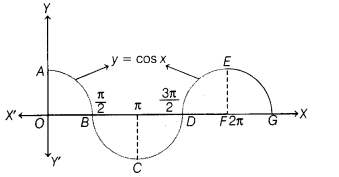
∴ Required area = Area of region OABO + Area of region BCDB +
Area of region DEFD
[∵ in region BCDB, the curve is below the X-axis, where yalue
comes out to be negative, so we take the absolute value]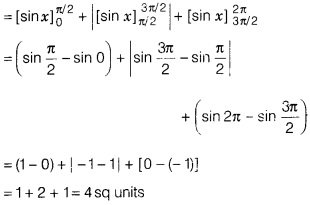
Therefore, the required area is 4 sq units
Or
The equation of the given
cur e is y² = 4a²(x – 1) or (y – 0)² – 4a²(x – 1).
Clearly, this equation represents a parabola with vertex at (1, 0) as shown in figure.
The region encloser by y² = 4a²(x – 1), x = 1 and y = 4a is the area of s.
iaded portion in figure.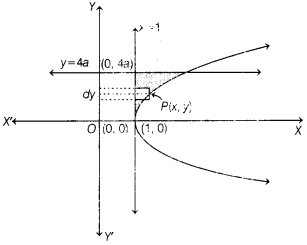
When we slice the area of the shaded portion in horizontal strips, we observe that each strip has left end on the line x = 1 and the right end on the parabola y² = 4a²(x – 1).
So, the approximating rectangle shown in figure has, length = x – 1, width =
dy and area = (x -1 )dy.
Since, the approximating rectangle can move from y =
0 to y = 4a.
So, required area A is given by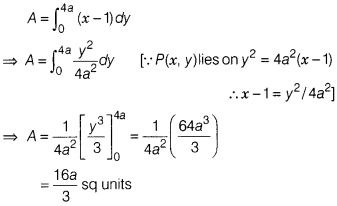
Question 30.
Let A = R – {3}, F = R – {1}. If f : A → B be defined by f(x)
= \(\frac{x-2}{x-3}\), ∀ x ∈ A, then show that f is bijective.
Solution:
Given, A = B – {3}, B = R – {1} and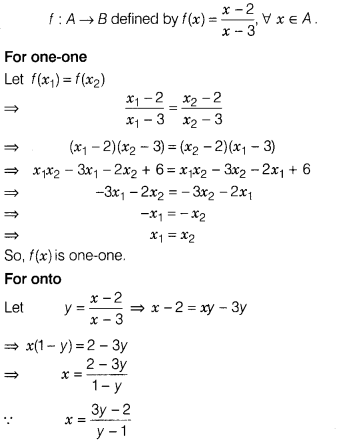
Clearly, x ∈ R – {3}, ∀ y ∈ R – {1}
So, range of f(x) = R
– {1}
∴ Range = Ccdomain
So, f(x) is onto.
Thus, f(x) is bijective.
Question 31.
Find the position vector of a point C which divides the line
segment joining A and B, whose position vectors are \(2\vec{a}+\vec{b}\) and
\(\vec{a}-3\vec{b}\), externally in the ratio 1 : 2. Also, show that A is the
mid-point of the line segment BC.
Solution:
Given,
\(\vec{OA}=2\vec{a}+\vec{b}\) and \(\vec{OB}=\vec{a}-3\vec{b}\) …(i)
Also, it
is given that C is the point which divides the line joining A and B externally
in the ratio 1:2.
Then, by using section formula of external division, we
get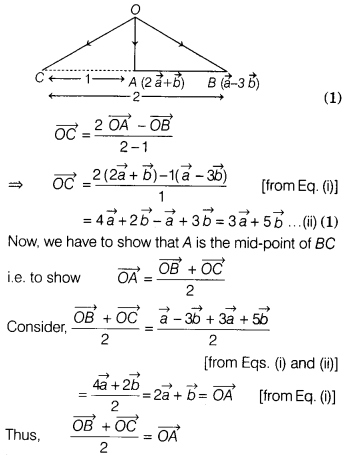
Hence, A is mid-point of line segment BC.
Section
D
This section comprises of long
answer type questions (LA) of 5 marks each
Question 32.
By computing shortest distance, determine whether the
following pair of lines intersect or not
\(\vec{r}=(4\hat{i}+5\hat{j})+\lambda(\hat{i}+2\hat{j}-3\hat{k})\) and
\(\vec{r}=(\hat{i}-\hat{j}+2\hat{k})+\mu(2\hat{i}+4\hat{j}-5\hat{k})\).
Solution:
Given equations of lines are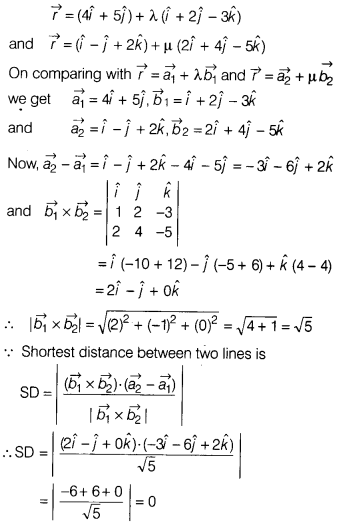
Hence, the two lines intersect each other.
Question 33.
Find a vector of magnitude 5 units, perpendicular to each of
the vectors
(\(\vec{a}+\vec{b}\)) and (\(\vec{a}-\vec{b}\)), where
\(\vec{a}=(\hat{i}+\hat{j}+\hat{k})\) and
\(\vec{b}=(\hat{i}+2\hat{j}+3\hat{k})\).
Solution: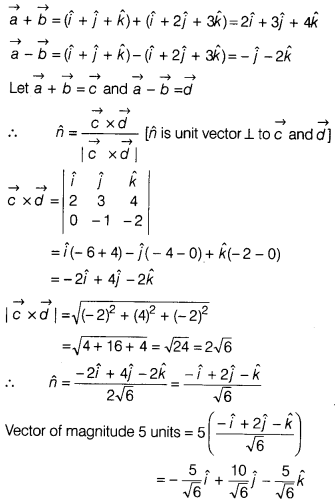
Question 34.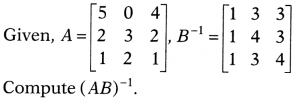
Or
Determine the product of
solve the system of equations x – y + z = 4, x – 2y – 2z = 9
and 2x + y + 3z = 1.
Solution: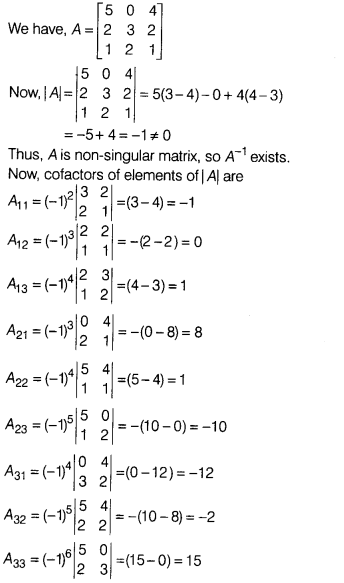
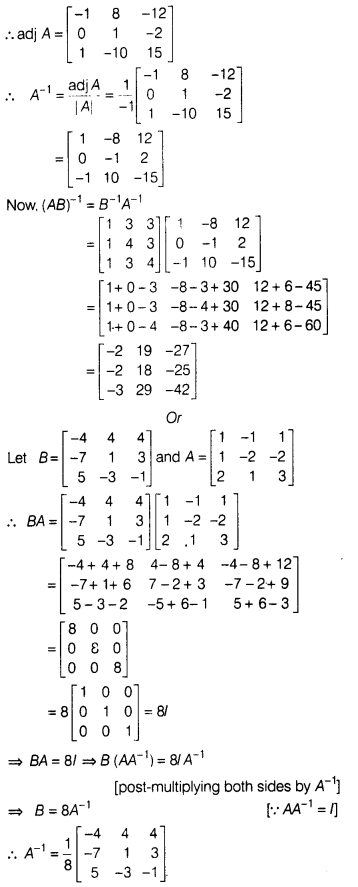
Given system of equations can be written in matrix form
as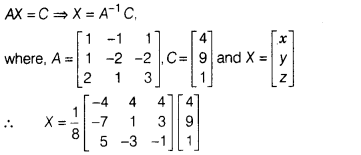

On comparing corresponding elements, we get
x = 3, y = 2
and z = -1
Question 35.
then find AB. Use this to solve the system of equations
x
– y = 3, 2x + 3y + 4z = 17 and y + 2z =7.
Or
equation A³ – A² – 3A – 1 = 0.
Solution: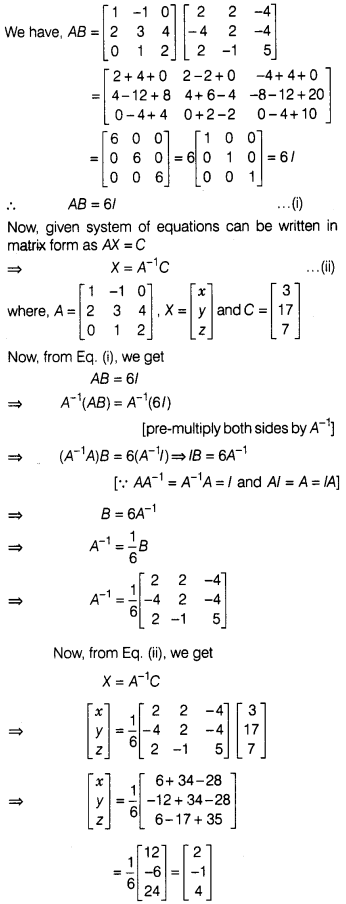
On comparing corresponding elements, we get
x = 2, y = -1
and z = 4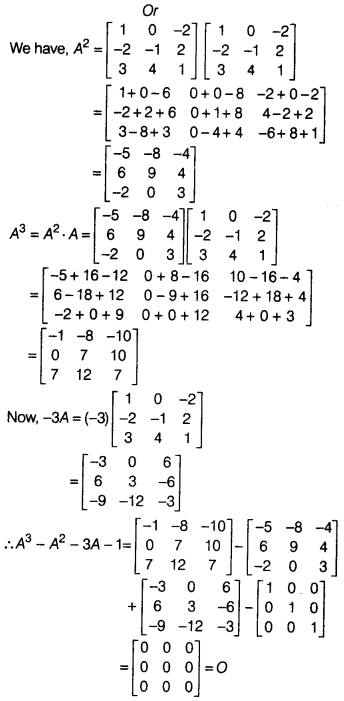
Section
E
This section comprises of 3
case-study/passage-based questions of 4 marks each
Question 36.
Sometimes, x and y are given as functions of one another
variable, say x = Φ(t), y = Ψ(t) are two functions and t is a variable. In such
a case, x and y are called parametric functions or parametric equations and t is
called the parameter.
To find the derivatives of parametric functions, we use
following steps
I. First, write the given parametric functions, suppose x =
f(t) and y = g(t), where t is a parameter.
II. Differentiate both functions
separately w.r.t. parameter t by using suitable formula i.e. find
\(\frac{dx}{dt}\) and \(\frac{dy}{dt}\).
III. Divide the derivative of one
function w.r.t. parameter by the derivative of second function w.r.t. parameter,
to get required value i.e. \(\frac{dy}{dx}\).
where f'(t) = 0.
On the basis of above information, answer
the following questions.
(i) If x = log t and v = cos t, then find
\(\frac{dy}{dx}\).
(ii) If x = at³ and y = t² + 1, then find
\(\frac{dy}{dx}\) at t = \(\frac{2}{3}\)
(iii) If x = cos t + sin t and y =
sin t – cos t, then find \(\frac{dy}{dx}\) at t = \(\frac{\pi}{2}\).
Or
If
x = 4 cos t and y = 8 tan t, then find \(\frac{dy}{dx}\) at t =
\(\frac{\pi}{4}\)
Solution: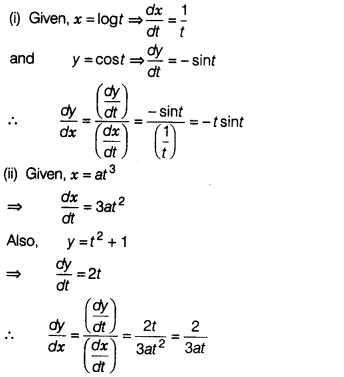
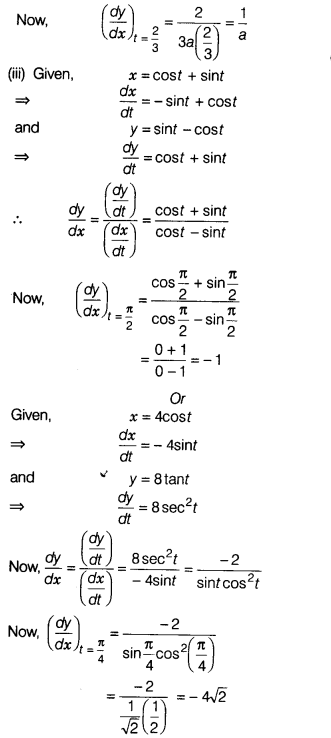
Question 37.
If feasible solution of a LPP is given as follows: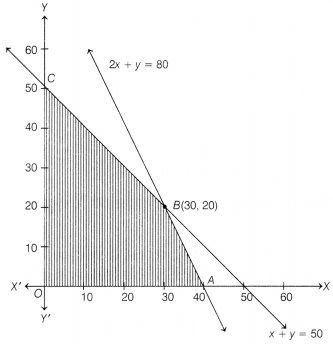
And the objective function is Z = 10500x + 9000y.
On the
basis of above information, answer the following question.
(i) If n is the
number of corner points, then find the value of (n + 2 )³.
(ii) Find the
value of Z(1, 1)
(iii) Find the point where objective function is
maximum.
Or Evaluate Z|(20, 20)– Z|(10, 10).
Solution:
(i) We have, n = 4
∴ (n + 2)³ = (4+ 2)³ = 6³ = 216 ….(i)
(ii)
Z(1, 1) = (10500 × 1) + (9000 × 1) = 19500
(iii) To know the
maximum value of Z, we need coordinates of all the corner points.
We have,
equation of lines x + y = 50 … (i)
and 2x + y = 80 …(ii)
For point A, on
putting y = 0 into Eq. (ii), we get
2x + 0 = 80 –
⇒ x = 40
⇒ A(40,
0)
For point C, on putting x = 0 into Eq. (i), we get 0 + y = 50
⇒ y = 50
⇒ C(0, 50)
Now,
| Comer points | Value of Z = 10500x + 9000y |
| 0(0, 0) | 10500 × 0+ 9000 × 0 = 0 |
| A(40, 0) | 10500 × 40 + 9000 × 0 = 420000 |
| B (30, 20) | 10500 × 30 + 9000 × 20 = 495000 (Maximum) |
| C (0, 50) | 10500 × 0 + 9000 × 50 = 450000 |
Hence, Z is maximum at B(30, 20).
Or
Z|(20, 20) –
Z|(10, 10)
= (10500 × 20 + 9000 × 20) – (10500 × 10 + 9000 ×
10)
= 1000 [(105 × 2 + 90 × 2) – (105 + 90)]
= 1000 [(210 + 180) –
(195)]
= 1000 [390 – 195] = 195000
Question 38.
Given three identical boxes I, II and III, each containing
two coins. In Box I both
coins are gold coins, in Box II both are silver
coins and in Box III there is one gold and one silver coin. A person choose a
box at random and takes out a coin.
On the basis of above information, answer
the following questions.
(i) Find the total probability of drawing gold
coin.
(ii) If drawn coin is of gold, then find the probability that other
coin in box is also of gold.
Solution:
Consider the following events,
E1 = Box I is choosen,
E2 = Box II is choosen,
E3 = Box III is choosen.
A = The coin drawn is of gold.
Clearly, P(E1) = P(E2) = P(E3) =
\(\frac{1}{3}\)
Then, P(A/E1) = Probability of drawing a gold coin
from Box I
= \(\frac{2}{2}\) = 1,
P(A/ E2) = Probability of
drawing a gold coin from Box II
= 0
and P(A/E3) = Probability
of drawing a gold coin from Box I
= \(\frac{1}{2}\)
(i) ∴ Required
probability